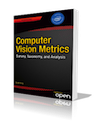|
Dear Colleague,
I'm pleased to announce that the invited talks from the September 2014 Embedded Vision Alliance member meeting are now published on the website. As usual, they are an informative, interesting and entertaining set of presentations, spanning a diversity of computer vision topics:
-
Dr. Ren Wu, Distinguished Scientist at Baidu, describes how his company is leveraging heterogeneous computing for "deep learning" visual search acceleration purposes
-
Matt Bell, co-founder and Chief Strategy Officer at Matterport, discloses how his innovative start-up is using low-cost 3D imaging to bring value to multiple industries
-
Mel Spiese, Vice President of Training Strategy and Effectiveness at Cubic, discusses the high priority his company has placed on vision technology in its defense and transportation systems
-
Linley Gwennap, founder and principal analyst of The Linley Group, explains the technology and market trends of processors for embedded vision applications, and
-
Scott Krig, the author of "Computer Vision Metrics: Survey, Taxonomy, and Analysis" (freely available on the Alliance website), provides an introduction to feature descriptors in vision processing applications
I encourage you to audition the above videos at your earliest convenience, along with those from past Member Meetings. And while you're on the Alliance website, make sure you check out all the other great new content published there in recent weeks, such as two of the appendices from the book "Computer Vision Metrics," news about the finalized OpenVX v1.0 computer vision API specification, and several press releases from Alliance member companies. Thanks as always for your support of the Embedded Vision Alliance, and for your interest in and contributions to embedded vision technologies, products and applications. As always, I welcome your suggestions on what the Alliance can do to better service your needs.
Brian Dipert
Editor-In-Chief, Embedded Vision Alliance
|
|
"Using Heterogeneous Computing for Mobile and Embedded Vision," an Embedded Vision Summit Technical Presentation from Rick Maule of Qualcomm
Rick Maule, Senior Director of Project Management at Qualcomm, presents the "Using Heterogeneous Computing for Mobile and Embedded Vision" tutorial within the "Implementing Vision Systems" technical session at the October 2013 Embedded Vision Summit East. A single vision application typically incorporates multiple algorithms requiring many different types of computation. This diversity makes it difficult for a single type of processing engine, such as the CPU, to execute vision applications with maximum efficiency. In this presentation, Qualcomm explores the potential for implementing vision applications on heterogeneous processor chips — that is, chips consisting of multiple processing engines of different architecture types, such as the CPU, GPU, and DSP . Using mobile devices as an example, we investigate the opportunities, challenges, trade-offs and techniques associated with mapping vision applications onto heterogeneous processing engines, particularly for applications requiring maximum energy and thermal efficiency.
"Who Watches the Machines Watching You?," an Embedded VIsion Alliance Member Meeting Presentation from Brian Wassom of Honigman Miller Schwartz and Cohn, LLP
Brian Wassom, Partner and Chair of the Social, Mobile, and Emerging Media Practice Group at Honigman Miller Schwartz and Cohn, LLP, presents "Who Watches the Machines Watching You? Regulating Privacy in the Era of Machines That See" at the March 2014 Embedded Vision Alliance Member Meeting. His talk discusses the legal considerations at the nexus of privacy, social media and technology.
More Videos
|
|
Computer Vision Metrics: Survey, Taxonomy, and Analysis
Computer Vision Metrics provides an extensive survey and analysis of over 100 current and historical feature description and machine vision methods, with a detailed taxonomy for local, regional and global features. This book provides necessary background to develop intuition about why interest point detectors and feature descriptors actually work, how they are designed, with observations about tuning the methods for achieving robustness and invariance targets for specific applications. The survey is broader than it is deep, with over 540 references provided to dig deeper. The taxonomy includes search methods, spectra components, descriptor representation, shape, distance functions, accuracy, efficiency, robustness and invariance attributes, and more. Rather than providing 'how-to' source code examples and shortcuts, this book provides a counterpoint discussion to the many fine opencv community source code resources available for hands-on practitioners. More
The Gateway to Smart Security in the Home
The word "Smart Home"� continues to be kicked around, but what does it truly mean for home security? The answer, change. For years, consumers have depended on the services of traditional monitoring stations and alarm companies. Equipment was simple, and easy to use and did what it needed to do. Then in 2007, came the first iPhone from Apple Inc., one of the first cell phones to deploy a multi-touch interface and in 2008 the release of Android, an open-source platform. These two releases have changed the way in which consumers interact, not only with each other but also other devices. Fast forward to 2014, the alarm industry is now in a period of change. More
More Articles
|







